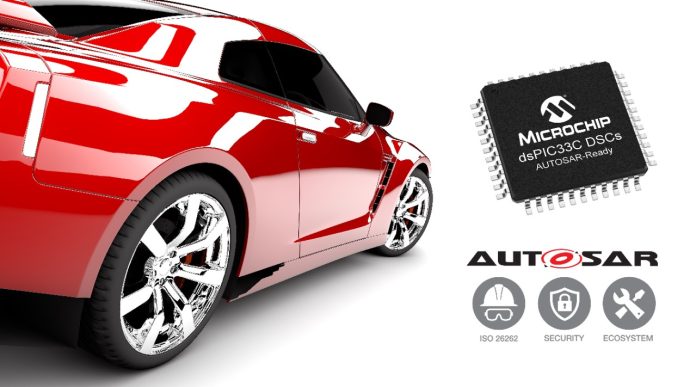Automotive Open System Architecture (AUTOSAR) addresses the challenge of increasing software complexity by providing an open and exchangeable solution to standardize the software architecture for automotive Electronic Control Units (ECUs). This empowers you to create innovative electronic systems that offer improved quality, performance, safety and security.
For automotive developers looking to design scalable applications for future technology while also meeting the latest automotive requirements, Microchip Technology Inc. had announced a comprehensive ecosystem around AUTOSAR-ready dsPIC33C Digital Signal Controllers (DSCs) to enable accelerated development and a high level of system optimization while reducing total system cost.
For more on AUTOSTAR ecosystem and its array of industrial applications, Times EV Sub Editor Mayank Vashisht got the opportunity to have a conversation with Yan Goh, Senior Business Development Manager, Automotive Products Group, Microchip Technology Inc. Excerpts:

Times EV: Could you elaborate on the detail of what is included in the “AUTOSAR-ready devices and ecosystem”?
Microchip has been delivering AUTOSAR-ready devices in the dsPIC33C digital signal controller (DSC) and PIC32 and SAM microcontroller families. With the AUTOSAR ecosystem around the dsPIC33C DSCs, we provide various MCAL packages compliant with AUTOSAR 4.3.x. Our MCALs are developed with ASIL and ASPICE compliance. To facilitate the ease of implementation for our customers, we have worked with well-established third-party partners in the automotive segment including Vector and KPIT to offer off-the-shelf support for AUTOSAR BSW and OS for the dsPIC33C DSC AUTOSAR-ready families. In anticipation of automotive security requirements, our unique proposition also offers an AUTOSAR-ready crypto driver which will work seamlessly with Microchip’s TrustAnchor100 (TA100) CryptoAutomotive device together with dsPIC33C DSCs. To enable customers to implement functional safety in their designs, we offer ISO 26262-compliant dsPIC33C DSCs and functional safety packages that simplify the design and certification of safety-critical applications.
Times EV: What does it mean for customers to have an ISO 26262 compliant and AUTOSAR-ready device and ecosystem? What are the benefits?
We see both ISO 26262 and AUTOSAR go hand-in-hand when developing a next-generation automotive electronic control unit (ECU) as automotive OEMs are putting greater emphasis on functional safety, standardization and platform-based development to reduce risk while gearing up for the fast adoption of electrification, autonomous driving-ADAS technology in cars today. ISO 26262, generally known as functional safety, forms an integral part of every automotive module development. It covers a wide aspect of target safety level, the entire development process down to production and the validation process with the aim to achieve ISO 26262 functional safety standards. AUTOSAR on the other hand covers the development aspect surrounding the software implementation for the microcontrollers or SoC used. This is critical as today’s car requires far more ECUs running on various high-speed bus systems, and most importantly requires a huge amount of embedded software to run. AUTOSAR ensures standardization, reusability and interoperability during software development addressing various design complexities.
The AUTOSAR-ready and ISO 26262-compliant dsPIC33C DSCs and the ecosystem enable automotive engineers to develop safety-critical applications and go for certification with ease while achieving standardization and scalability with AUTOSAR support. The overall ecosystem reduces the development time. With the large memory dsPIC33C DSCs, our customers are enabled to achieve a high level of integration in their applications by implementing AUTOSAR, ISO 26262 functional safety and security.
Times EV: Are there any special points of interest in the hardware architecture of the dsPIC33CK1024MP7xx series compared to previous products?
dsPIC33CK1024MP7xx DSCs are the latest additions to Microchip’s wide portfolio of dsPIC33C DSCs. This new family of dsPIC33C DSCs is designed following the ISO 26262 functional safety standard and comes with a range of dedicated hardware safety features. Leveraging on our experiences, we have improved the chip design architecture with commonality in mind where we offer the single core and dual core architectures. Offering larger memory and a rich feature set, the dsPIC33C DSCs are designed with high performance, deterministic response and low latency interrupt to target real-time applications. As mentioned earlier, support for security is considered with the dsPIC33C DSCs offering complimentary security features to work together with Microchip’s CryptoAutomotive solutions.
Times EV: The automotive MCU market is very competitive, what type of features of the dsPIC33C DSC family make it more suitable for automotive and electric vehicle designs than its competitors?
Microchip holds a niche position in the automotive segment with our dsPIC33C family. We developed our solutions targeting especially EV or ADAS applications such as motor controls, electrical management such as OBC, BMS, DC/DC ECU, actuator-sensor, ECU and lighting ECU. As a key differentiator, we designed our dsPIC33C to meet the high-speed analog requirements with advanced ADCs, op-amps, and high-speed analog CMPs, which are needed for high-efficiency digital power and advanced sensor interfacing designs. These advanced features coupled with our excellent reference design and software support enable our customers to develop solutions with ease.
Times EV: We have sorted out the following news about dsPIC33C in the automotive field in recent years: such as the new dual-core and single-core dsPIC33C DSCs coming in 2019 with an emphasis on “automotive and wireless charging applications”; the ISO 26262 functional safety package for dsPIC33C DSCs in 2021; and this year’s focus on “AUTOSAR-ready”. What do you think is the reason for “AUTOSAR-ready” being this year’s focus, is it because it is more difficult to develop or for other reasons?
AUTOSAR history started in 2003 and has been evolving since. It is definitely more challenging to develop from a technical perspective and there is a learning curve for all Tier 1 suppliers. As time has passed, AUTOSAR capability within Tier 1 and OEM is at the level where mass adoption starts. This growth is also due to the fact that new automotive platform development introduced across the board focuses on higher safety requirements, more electronic functionality covering a wide range of aspects such as HMI, ADAS, autonomy and last but not least, electrification. With so much more complexity, the adoption of AUTOSAR is one of the key ingredients considering all the benefits it brings.
Times EV: What are the main applications of 16-bit MCUs in automobiles? Is it a concern that the 16-bit MCU market share may go down as 32-bit MCUs are currently capturing the automotive market?
Microchip offers microcontroller choices from 8-bit to 32-bit MCUs. From our perspective, each 8 – 16 – 32-bit MCU has its own place and specific target focus application ECU within the automotive segment. It is not about one particular segment cannibalizing the weaker segment, instead, each MCU has its own unique position and strength to address the particular functionality. For example, in a simple switch module with LIN interface, an 8-bit MCU can easily fulfil all the requirements and it would be an overkill to use a 32-bit MCU. Focusing on our dsPIC family which offers a range of features that are customized for deterministic and high-performance results, it is well adapted for high-speed real-time response applications such as various motor controls (FOC, BLDC/PMSM), electrification ECUs such as OBC, BMS, DC-DC inverters and safety-critical designs related to steering wheel switch and sensor modules. The dsPIC33 family is more defined by the application-specific features and the ecosystem it offers to fit the automotive applications.
Times EV: Many people think that AUTOSAR specification is prepared for the traditional automotive industry. As we enter the era of intelligence, with the shift from distributed to domain-centralized automotive electronic architecture, the AUTOSAR specification starts to become less suitable, even with the development of Adaptive AUTOSAR. What are your thoughts on this?
We would view that the opposite will happen. As vehicle electronics architecture shifts towards the zonal-based system, additional embedded software will be required for each connected ECU. As a result, AUTOSAR will also be required considering all the benefits we have discussed earlier. Adaptive AUTOSAR is required in more high-end ECU in anticipation of the ADAS-Autonomous features. Both AUTOSAR standards are complementary and will be used together as they serve different needs and situations.
Mayank Vashisht | Sub Editor | Times EV








